The rotary effect is based on the popular Leslie speaker design. It is amongst the most unique modulation tools you can add to your pedalboard.
Whether you’re looking to add a sense of motion to a chord sequence or create textural sounds which add a new element to your live performances, using a rotary speaker pedal will transform your tone dramatically.
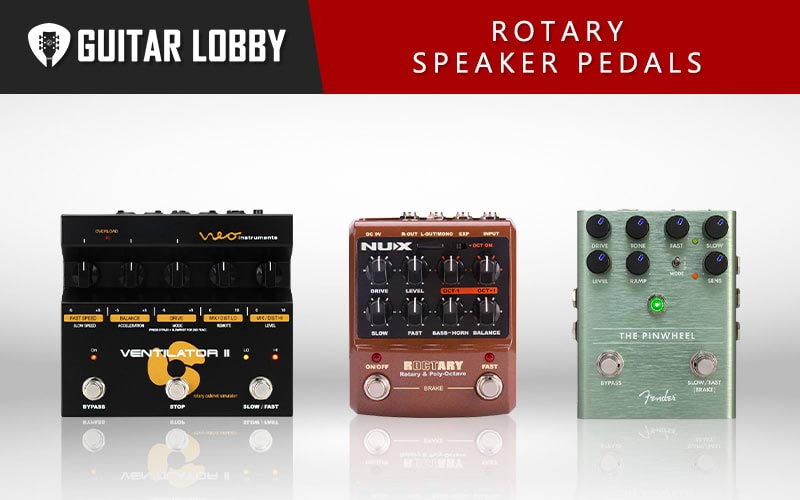
Over the years our team at Guitar Lobby has owned and tested dozens of rotary pedals, and in the rest of this article, we’ll present the best rotary guitar pedals at each price point so that you can make the right choice to suit your requirements.
| Name of Product | Image of Product | Description | Price Range | Full Review |
|---|---|---|---|---|
| 1. Fender The Pinwheel (Best Overall) | 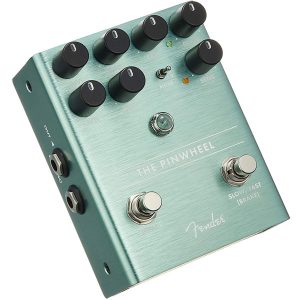 | Type: Analog Effects: Rotary | $270 | Read Full Review Below |
| 2. NUX Roctary (Best Value) | 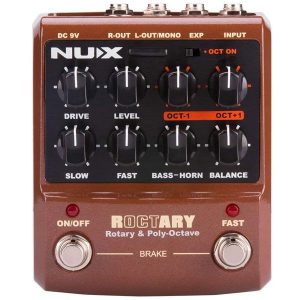 | Type: Analog Effects: Rotary, Octave | $130 | Read Full Review Below |
| 3. DigiTech Ventura Vibe (Best Under $100) | 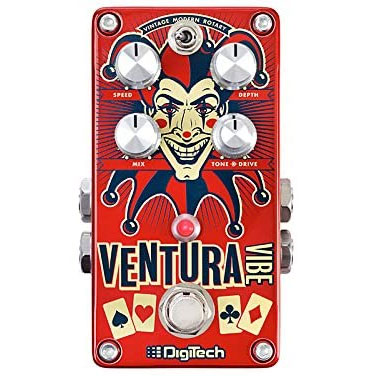 | Type: Analog Effects: Rotary, Vibrato | $100 | Read Full Review Below |
| 4. NUX MOD Core Deluxe (Best Under $75) | 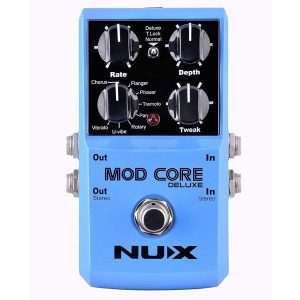 | Type: Digital Effects: Rotary, Multi-FX | $75 | Read Full Review Below |
| 5. Neo Instruments Ventilator II | 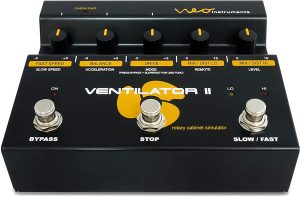 | Type: Digital Effects: Rotary | $500 | Read Full Review Below |
| 6. Strymon Lex | 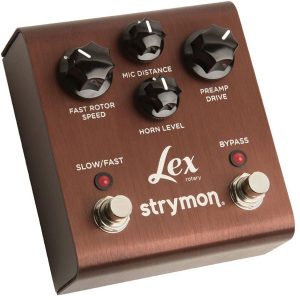 | Type: Analog Effects: Rotary | $300 | Read Full Review Below |
| 7. Danelectro Billionaire BK-1 | 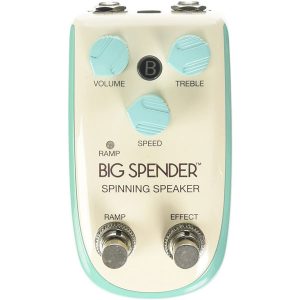 | Type: Analog Effects: Rotary | $170 | Read Full Review Below |
| 8. Wampler Terraform | 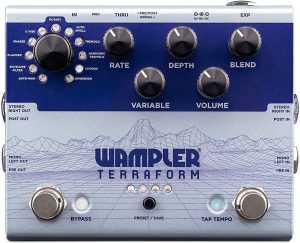 | Type: Digital Effects: Rotary, Multi-FX | $300 | Read Full Review Below |
| 9. Electro-Harmonix Lester K | 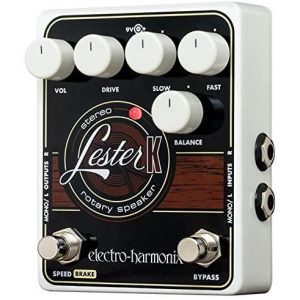 | Type: Analog Effects: Rotary | $260 | Read Full Review Below |
| 10. TC Electronic Vibraclone | 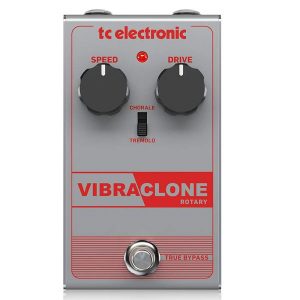 | Type: Digital Effects: Rotary, Tremolo, Chorus | $100 | Read Full Review Below |
| 11. Neo Instruments Mini Vent II | 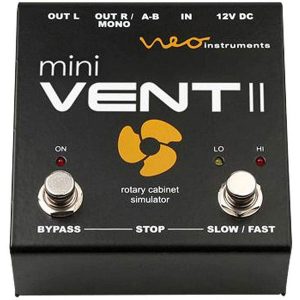 | Type: Digital | $400 | Read Full Review Below |
| 12. Keeley Dyno My Roto | 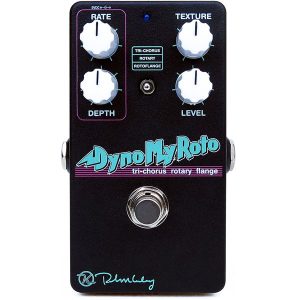 | Type: Digital Effects: Rotary, Chorus, Flanger | $170 | Read Full Review Below |
| 13. Aroma Roto Engine | 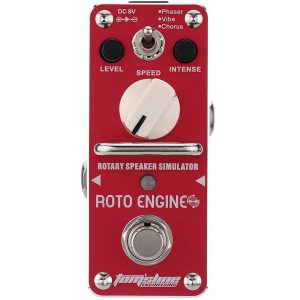 | Type: Analog Effects: Rotary | $50 | Read Full Review Below |
| 14. Kokko Vibe | 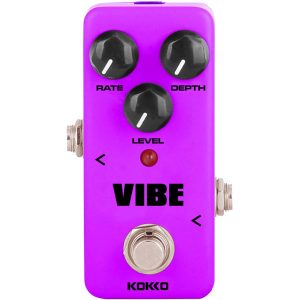 | Type: Analog Effects: Rotary | $40 | Read Full Review Below |
| 15. Coolmusic A-ME01 | 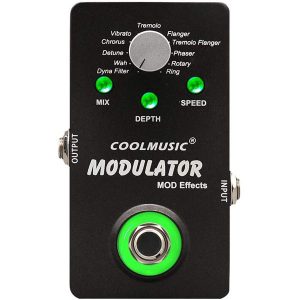 | Type: Analog Effects: Rotary, Multi-FX | $50 | Read Full Review Below |
| 16. Electro-Harmonix Lester G Deluxe | 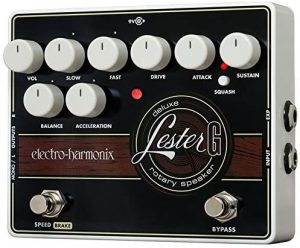 | Type: Analog Effects: Rotary | $390 | Read Full Review Below |
| 17. Flamma FC05 | 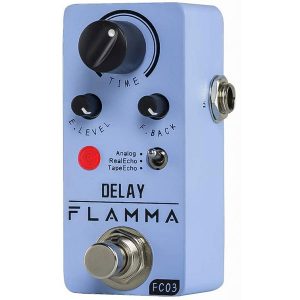 | Type: Analog Effects: Rotary, Multi-FX | $40 | Read Full Review Below |
Here Are the Best Rotary Speaker Pedals
1. Fender The Pinwheel (Best Overall)
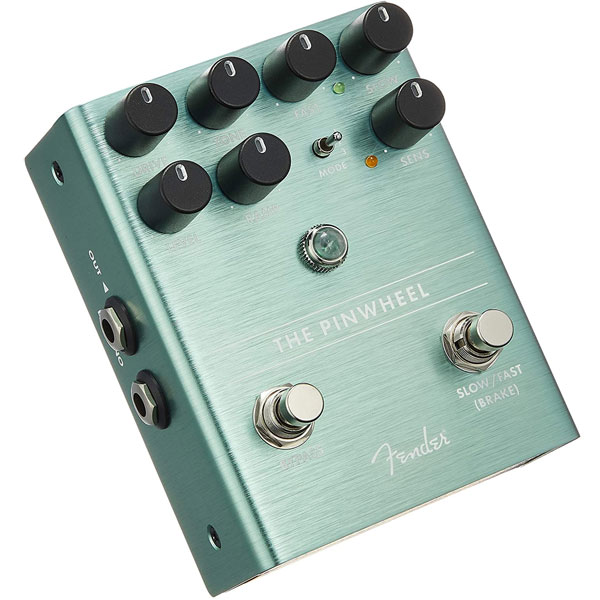
| Estimated Price | $270 |
| Type | Analog |
| Effects | Rotary |
| Connectivity | 2 x 6.35mm Jack Input, 2 x Output |
| Power | 9 Volts DC |
My Review: Being a huge admirer of Fender’s range of instruments and amplifiers, I could be accused of being a little biased toward this legendary manufacturer. However, I was genuinely impressed by the functionality, sonic quality, and versatility of The Pinwheel, their flagship rotary speaker emulator.
One of the things that sold me on this pedal was its trio of distinctive rotary presets. I found that The Pinwheel sounded its best when the ‘Break’ function was engaged on the right-sided footswitch, which leads to a thick, full-bodied quality being added to the guitar’s tone. When I added a little saturation using the ‘Overdrive’ control, I was impressed by the sharp lead tones the pedal produced.
In my opinion, a rotary pedal is defined by its extremes. Not only should it produce the dramatic spinning effect of a Leslie speaker, but it should also offer more subtle forms of modulation. After testing out The Pinwheel, I was pleased to discover it housed a plethora of spacey, mind-boggling sounds, in addition to less intense versions of the rotary effect.
The unique quality of this boutique Fender pedal which makes it one of the best rotary simulators on the market is the brilliant sound of its onboard overdrive. I had my doubts about adding overdrive to the signal, as I worried it would cause the sound to become muddy and harsh. On the contrary, I found the warm saturation to be ideally suited to increase the prominence of certain frequencies of the guitar while the rotary effect was engaged.
Who is this best suited for: The Pinwheel by Fender provides a total of seven adjustable controls, which an additional mode selector switch. Consequently, it’s best suited to guitarists who some experience with modulation, and are willing to take some time to learn how each parameter impacts the rotary effect.
Bottom Line: Durable, sleekly designed, and exceptionally functional, Fender’s The Pinwheel is one of the best rotary speaker simulator pedals I’ve ever encountered. With various controls affecting the speed and tonal qualities of the effect, and a generous number of connectivity options included, this pedal would make a great addition to anyone’s signal chain.
2. NUX Roctary (Best Value)
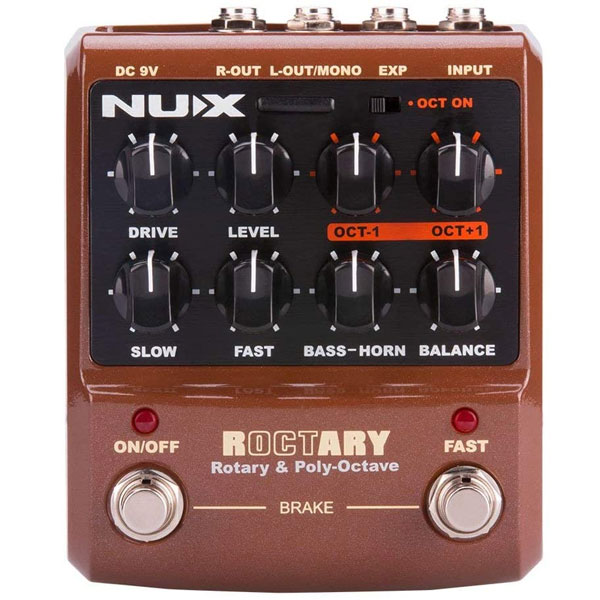
| Estimated Price | $130 |
| Type | Analog |
| Effects | Rotary, Octave |
| Connectivity | 2 x 6.35mm Jack Input, 2 x Outputs |
| Power | 9 Volt |
My Review: Right after my first encounter with the Roctary by NUX, I was impressed by its ability to authentically reproduce the effect of a Leslie speaker cabinet. One aspect of the pedal which caught my attention was the octave section, as this is a rare feature on rotary devices.
By adding sub or higher octaves to the rotary effect, I was able to successfully make my guitar sound like a synthesizer. Combining this with a spring reverb pedal is a great way to create dreamy, ambient modulation which can be controlled using the various parameters on the Roctary.
The ‘Slow’ regulator is another aspect of the Roctary which I found very useful. The effect it has on the harmonics of a guitar or organ is instantly felt, even when this control is used subtly. I did find that I had to be careful when adding some of the pedal’s overdrive into the mix, as this can easily lead to a little loss of the treble and bass frequencies if you overdo it.
As a Leslie speaker unit simulator, this pedal performs solidly. The thing that I believe sets it apart from other similarly priced stompboxes is the octave control, which is essentially like having a POG built into your rotary pedal, expanding the tonal possibilities. In my opinion, this might be the best Leslie pedal around, especially at this value.
Who is this best suited for: Synth players, keyboardists, and guitar players who require a versatile rotary unit will enjoy using the NUX Roctary. It’s also a great choice for those who like to control their effects using an expression pedal.
Bottom Line: Boasting a total of eight adjustable controls that can be used to alter every aspect of the rotary effect, this NUX pedal is amongst the most detailed devices in its field. The addition of poly-octave shifting opens up the door to a new realm of modulated sonic possibilities.
3. DigiTech Ventura Vibe (Best Under $100)

| Estimated Price | $100 |
| Type | Analog |
| Effects | Rotary, Vibrato |
| Connectivity | 2 x 6.35mm Jack Input, 2 x Output |
| Power | 9 Volts DC |
My Review: Almost all of the DigiTech effects pedals I’ve tested have left me very impressed by their quality and ease of operation. I can safely say that the Ventura Vibe is up there with the very best this prolific manufacturer has to offer.
Many pedals claim to effectively simulate the revered Leslie speaker effect, but I often can’t help feeling skeptical about whether they’re able to deliver on their promise. Right off the bat, I could tell that the Ventura Vibe, with its three modulation-based, presets and wide tonal palette was different from the majority of rotary pedals.
The ‘Tone & Drive’ combination control was the adjustable parameter that I found to be the most useful when shaping the sound of the pedal. I discovered that this control could be used similarly to a filter, except in addition to highlighting certain frequencies in the output, you can also add warm saturation which makes the effect sound more authentic.
The Ventura Vibe’s unique blend of chorus, vibrato and rotary effects is perfectly suited to creating ‘60s psych-rock sounds. I believe that its main strength is how easy it is for musicians to build their own unique rotary speaker-style tones, by simply using the presets as foundations, and adjusting the ‘Speed’, ‘Depth’, ‘Mix’, and ‘Tone & Drive’ controls.
Who is this best suited for: If your love for the rotary effect stems from the late ‘60s guitarists who popularized it, the Ventura Vibe provides an affordable and highly capable method of recreating those exact tones.
Bottom Line: With the Ventura Vibe, in my opinion, DigiTech has proven that you don’t need to spend a small fortune to access high-quality rotary, chorus, and vibrato effects. They’ve included all of the inputs and outputs a guitarist could need, and the modest selection of four controls ensures that the operation of the pedal is easy to grasp.
4. NUX MOD Core Deluxe (Best Under $75)
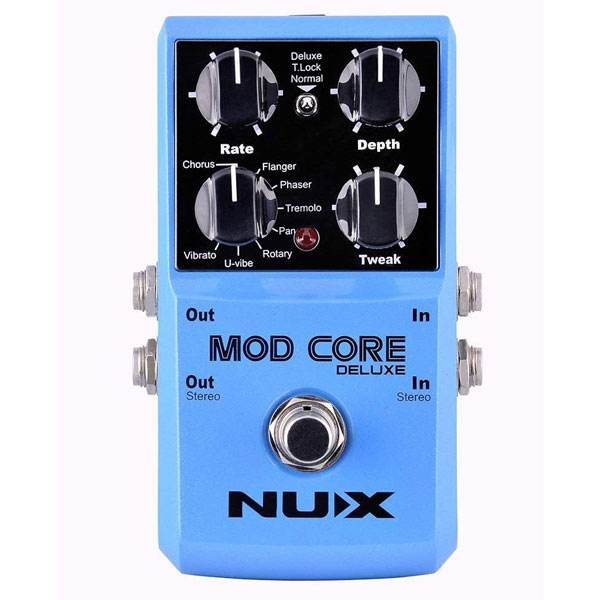
| Estimated Price | $75 |
| Type | Digital |
| Effects | Rotary, Multi-FX |
| Connectivity | 2 x 6.35mm Jack Input, 2 x Output |
| Power | 9 Volts DC |
My Review: Initially, I expected the MOD Core Deluxe to be somewhat of a complex pedal to use. I made this assumption based on the sheer volume of modulation effects housed within this modestly-sized stompbox. Despite my reservations, I found this pedal surprisingly straightforward to use.
A common concern with multi-effect modulation pedals is that the individual effects tend to suffer in terms of quality, due to the manufacturer focusing more on creating variety. However, after using the ‘Rotary’ preset, it soon became apparent that a lot of time and effort had gone into that particular effect.
Compared to other modulation multi-effects units, this NUX offering stands out mainly due to the effectiveness of its three adjustable parameters and three switchable modes. I was impressed by the way each of the 8 modulation effects could all be manipulated using the ‘Rate’, ‘Depth’, ‘Type’, and ‘Tweak’ settings.
Who is this best suited for: I would highly recommend the MOD Core Deluxe to guitarists who are looking to expand their signal chain to include more modulation-based effects. This multi-effects unit offers high-quality rotary simulation, but it also offers seven additional effects which will save you money, and space on your pedalboard.
Bottom Line: Featuring dual in/outputs for stereo and mono operation, three adjustable controls for shaping each of the eight selectable modulation effects, and a rotary simulator that shares many qualities with the legendary Leslie unit, the MOD Core Deluxe is a wise investment for all guitarists.
5. Neo Instruments Ventilator II
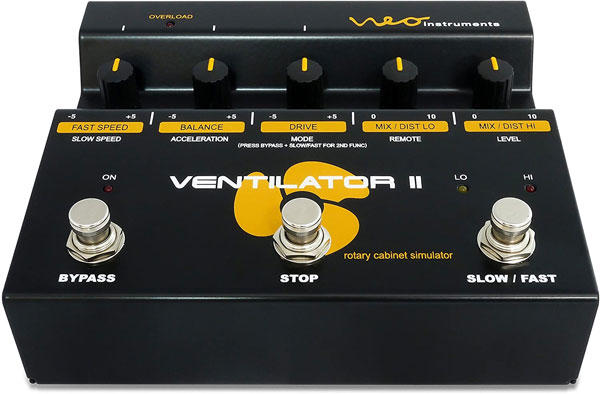
| Estimated Price | $500 |
| Type | Digital |
| Effects | Rotary |
| Connectivity | 2 x 6.35mm Jack Input, 2 x Output |
| Power | 9 Volts DC |
My Review: My first impression of the Ventilator II by Neo Instruments was that this pedal seemed to cover each aspect of the rotary cabinet effect, with an extensive selection of adjustable controls and three footswitches.
In terms of its physical attributes, it didn’t take long for me to realize that the pedal is solidly built, and its controls are laid out in a logical, easily usable manner. Moving on, I found the sonic qualities of the pedal to be equally as impressive. The only minor issue I wish that Neo Instruments would have addressed when designing the pedal is its sole reliance on unbalanced outputs. However, I believe this can be rectified by pairing the Ventilator II with a stereo DI box.
The Ventilator II’s competence is most evident when it’s used in mono mode. Unlike other similar rotary effect simulators, it adds additional tonal qualities to a guitar or organ’s output and therefore acts as an authentic amplifier/speaker emulator. In my opinion, this makes it a highly suitable option for amplifiers that produce an overall neutral tone, without desirable coloration or tube saturation.
Who is this best suited for: If you’re looking for an authentic recreation of the original Leslie speaker cabinet effect, this rotary pedal by Neo Instruments gets remarkably close to that highly sought-after sound.
Bottom Line: Providing ultimate control over the individual aspects of the rotary effect, the Ventilator II covers all bases. It’s housed in a solid metal chassis and each of the parameters forms an integral part of the tone-shaping of the effect. This pedal also simulates tube-amp style saturation very impressively.
6. Strymon Lex
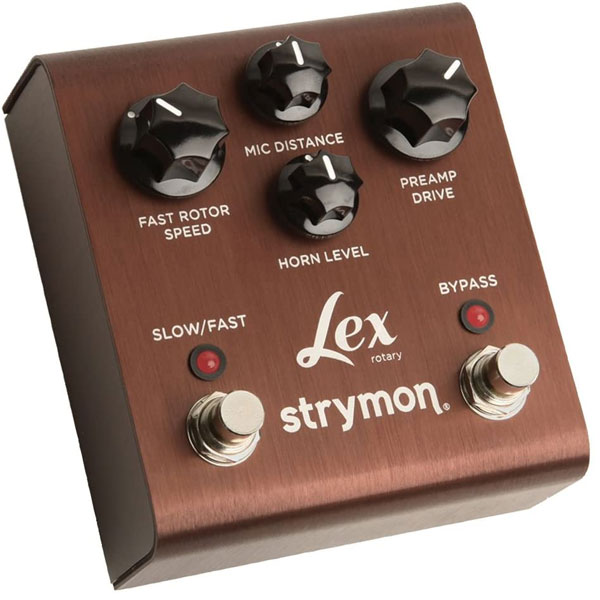
| Estimated Price | $300 |
| Type | Analog |
| Effects | Rotary |
| Connectivity | 1 x 6.35mm Jack Input, 2 x Output |
| Power | 9 Volts DC |
My Review: At Guitar Lobby, we’re huge admirers of Strymon. Their boutique effects pedals are always a joy to behold, and I’ve often been left awestruck by their attention to detail. When I first got my hands on the Lex rotary simulator pedal, I was expecting big things.
Firstly, I was particularly impressed by the pristine clarity of the rotary effect. When comparing the sound of the Lex to other boutique rotary pedals, I found that its output to be exceptionally consistent, with no dynamic or tonal weak spots.
I found it quite remarkable that Strymon managed to keep the dimensions of the pedal so compact while installing such a wide variety of rotary-based controls for shaping the effect. I must admit, it did take a little while to understand how the onboard controls work as each parameter has two functions. Nevertheless, the time I invested in figuring out the controls was worth it once I was able to enjoy the brilliant rotary effects produced by this pedal.
It’s easy for me to put my finger on the standout quality of the Strymon Lex pedal – its ability to reproduce the Leslie speaker unit effect with pinpoint accuracy. I’m yet to find another rotary pedal that emulates this effect as closely as the Lex can. Even when placed side by side with a genuine Leslie speaker, it’s hard to tell the difference between that and the Strymon Lex, which is very impressive indeed.
Who is this best suited for: Although the Strymon Lex is amongst the more expensive rotary pedals on the market, if you’re willing to invest a little extra you won’t be disappointed by the brilliant effects produced by this classy boutique device.
Bottom Line: The Lex rotary pedal by Strymon combines smooth functionality with a sonic clarity which most modulation pedals lack. With a wide range of rotary-based sounds housed within its chassis, this is the kind of pedal that leaves you wondering how you coped without it on your pedalboard! Overall, I’d say this is the best rotary speaker pedals out there right now.
Related Article: Must Have Guitar Pedals
7. Danelectro Billionaire BK-1
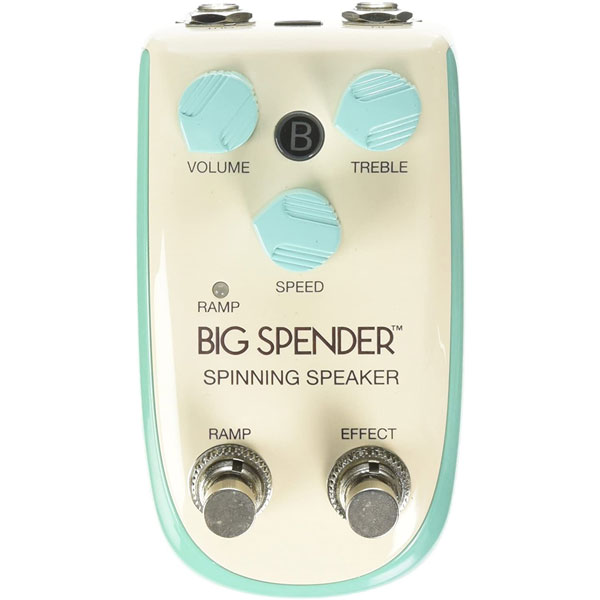
| Estimated Price | $170 |
| Type | Analog |
| Effects | Rotary |
| Connectivity | 1 x 6.35mm Jack Input, 1 x Output |
| Power | 9 Volts DC |
My Review: The Billionaire BK-1 initially struck me as a fairly simplistic rotary guitar pedal, but upon further analysis, I found that despite its minimalistic design, this small stompbox packs a range of spinning speaker sounds.
I found that the key to getting the most out of this pedal is striking the right balance between the ‘Volume’, ‘Speed’, and ‘Treble’ controls. Grit and warmth can be added to the signal by cranking up the volume, then adjusting the treble leads to a brighter or duller tone.
After I heard the spinning effects of the BK-1, it became apparent that this pedal produces a unique take on the classic Leslie speaker sound. Compared to other rotary pedals which offer this effect, the BK-1 sounds more artificial, which in my opinion isn’t necessarily a negative quality. It adds a synth-like feel to a guitar, whilst maintaining the natural tonal aspects of the instrument.
Who is this best suited for: The BK-1 is best suited to guitarists who are interested in pushing the boundaries of their instrument’s output. Not for the faint-hearted, it injects swirling rotation into the signal and is a highly effective tool for ambient and psych-rock styles.
Bottom Line: In many cases, limiting the number of controls on a modulation pedal can lead to its options also being narrowed. However, the BK-1 by Danelectro defies this preconception. Within the pedal, I found an array of spinning speaker effects, which can be tailored to your liking using the onboard rotary controls and footswitches.
8. Wampler Terraform
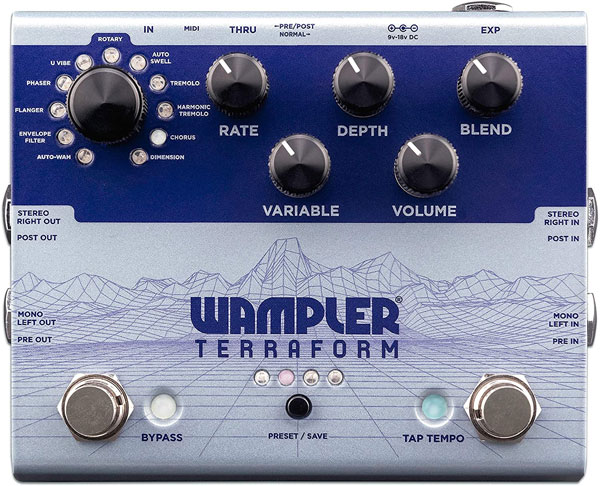
| Estimated Price | $300 |
| Type | Digital |
| Effects | Rotary, Multi-FX |
| Connectivity | 1 x 6.35mm Jack Input, 1 x Output |
| Power | 9 Volts DC |
My Review: I’ve come across many multi-effects modulation pedals in the past, but the Wampler Terraform stands out as one of the best in its field. Due to the extensive capabilities of this pedal, I was able to free up a lot of space on my pedalboard for additional dynamic, distortion, and timing-based effects.
The rotary simulator effect included in this pedal is as good as any standalone pedal. The thing that impressed me the most was the quality of the other ten modulation pedals. The only minor criticism I have of this Wampler device is that the preset switch is a little tricky to use, and I wish that the manufacturer had made it simpler to toggle through the settings. Nevertheless, the sounds included in the pedal are superb, and that makes up for the slight operational issues.
Who is this best suited for: The Terraform is best suited to guitarists who heavily use modulation effects as part of their signal chain. With a total of eleven modulations presets, it allows you to minimize the clutter on your pedalboard while accessing high-quality effects.
Bottom Line: Exceeding the capabilities of most rotary pedals, the Wampler Terraform produces high-quality modulation effects including uni-vibe, harmonic tremolo, and lush chorus. It’s also compatible with expression pedals and has multiple stereo and mono in/outputs to choose from.
9. Electro-Harmonix Lester K
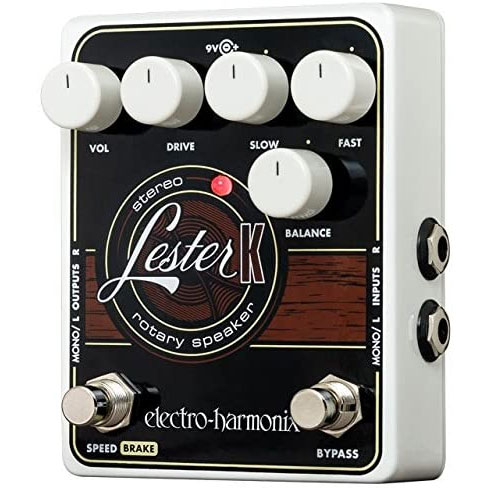
| Estimated Price | $260 |
| Type | Analog |
| Effects | Rotary |
| Connectivity | 2 x 6.35mm Jack Input, 2 x Output |
| Power | 9 Volts DC |
My Review: The Lester K by Electro-Harmonix is one of the most unique rotary pedals I’ve had the pleasure of encountering. Besides offering classic Leslie speaker-style rotation through a blend of vibrato and chorus, this solidly-built stompbox also impressed me with its ability to inject authentic-sounding tube overdrive into the output of my guitar.
The pedal’s ability to blend this rich overdriven tone with a swirling rotary effect is what, in my opinion, separates it from many similarly priced pedals. I’ve often been disappointed by the quality of tube-style saturation when it is included on modulation pedals, but Electro-Harmonix has proved that it can be done.
I can envisage this being an invaluable asset to those who use solid-state amplifiers but still want access to authentic tube break-ups.
Who is this best suited for: The Lester K is ideally suited to guitarists, keyboardists, or organ players who need a simple way to add rotary and overdrive effects to their instrument’s clean tone.
Bottom Line: Offering the durability that EHX pedals are renowned for, and simple operation thanks to the five self-explanatory control knobs, the Lester K is a high-performance rotary and overdrive combination pedal.
10. TC Electronic Vibraclone
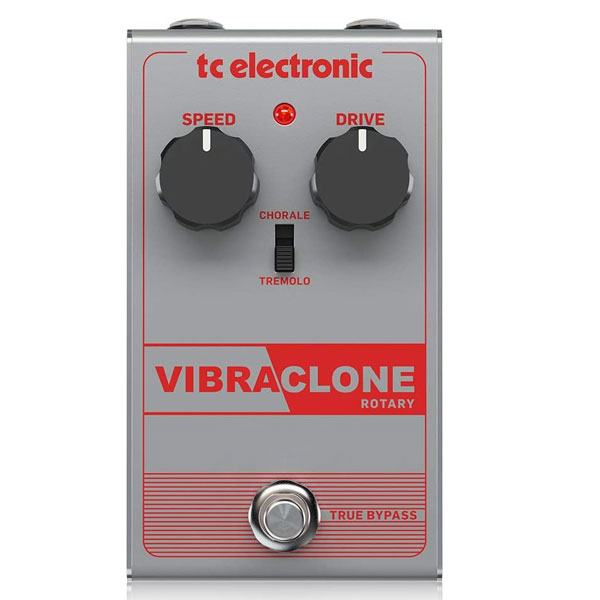
| Estimated Price | $100 |
| Type | Digital |
| Effects | Rotary, Tremolo, Chorus |
| Connectivity | 1 x 6.35mm Jack Input, 1 x Output |
| Power | 9 Volts DC |
My Review: The Vibraclone by TC Electronic caught my attention due to its retro design, and minimalistic layout. However, it didn’t take long for me to realize that this pedal is capable of producing a range of complex tones based on emulations of the Leslie rotating speaker effect.
After researching the pedal extensively, my findings indicate that it performs best when used as part of an isolated effects loop. Having another amplifier sound present alongside the Vibraclone allows it to flourish, without overwhelming the natural tone of the guitar.
Who is this best suited for: If you use a dual-amplifier set up in your rig, the TC Electronic Vibraclone is a great addition to your effects chain. I’d also recommend it to guitarists who have an EQ pedal, as it does tend to change the frequency response quite dramatically, so you may need to compensate for these adjustments.
Bottom Line: TC Electronic’s pedals tend to boast a wide range of adjustable parameters, but the Vibraclone deviates from this pattern. With two controls and a switch, it’s very easy to operate, but that doesn’t limit the number of rotary-based sounds you can create with this compact pedal.
Popular Related Article: The Best Pedalboards on the Market Right Now
11. Neo Instruments Mini Vent II
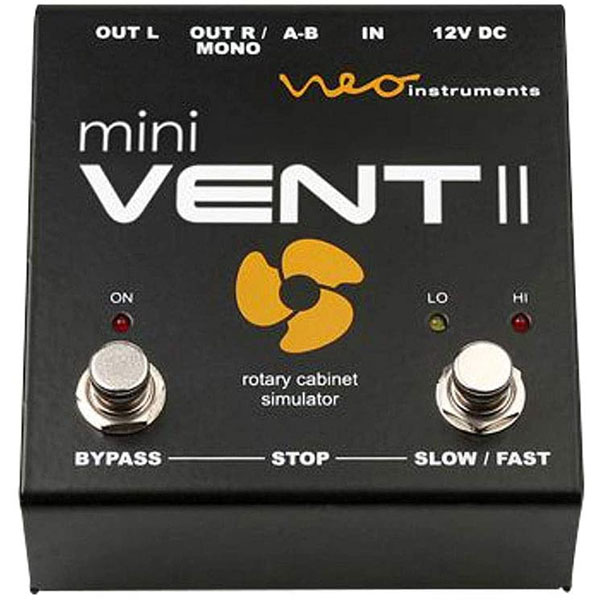
| Estimated Price | $400 |
| Type | Digital |
| Effects | Rotary |
| Connectivity | 1 x 6.35mm Jack Input, 2 x Output |
| Power | 9 Volts DC |
My Review: After experimenting with the Neo Instruments Mini Vent II, I was taken aback by the immersive Leslie speaker-style effects it produces. Running this pedal into two amplifiers produces some magical swirling tones which are ideal for guitar and keyboard.
The unique feature which makes this pedal stand out is the way the LED indicator responds to the pulsations of the rotary effect. I’d never experienced this on a pedal before, and being able to watch the indicator move in time with the rotations added a new element to the experience of using the pedal.
Who is this best suited for: The Mini Vent II is a great all-rounder. It comes very close to the original Leslie speaker rotary effect, so if you’re hoping to access that classic sound and don’t mind the extra cost, you won’t be disappointed.
Bottom Line: Many pedals claim to be authentic emulators of the Leslie 122 rotary effect, but few can deliver as impressively as the Neo Instruments Mini Vent II. It includes several improvements from the original model, with a switchable drive, and two distinctive presets acting as starting points for the high-quality modulation it produces.
12. Keeley Dyno My Roto
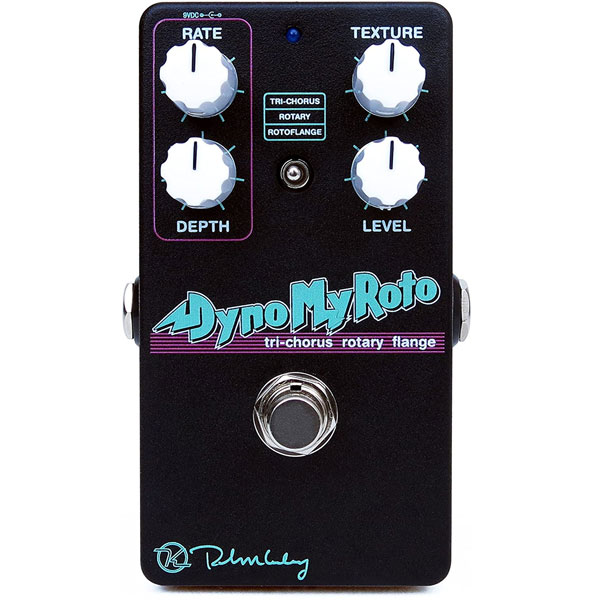
| Estimated Price | $170 |
| Type | Digital |
| Effects | Rotary, Chorus, Flanger |
| Connectivity | 1 x 6.35mm Jack Input, 1 x Output |
| Power | 9 Volts DC |
My Review: The Dyno My Roto pedal by Keeley is a reliable rotary pedal that I believe has something to offer both in the recording studio and a live performance environment. The three staple sounds housed within this pedal impressed me with their tonal depth and variations.
I was particularly intrigued by the ‘Rotoflange’ feature of the pedal. Combining rotary with a flanger effect is quite uncommon, but after checking it out I was left wondering why more modulation pedal manufacturers don’t include this unique blend of compatible effects.
The sweeping pulsations of the rotary effect merged with the tonal shifts of the flanger are ideal for creating mind-bending riffs or adding a different feel to chord sequences.
Who is this best suited for: The Dyno My Roto is a great choice for guitarists who want to combine chorus, rotary, and flanging effects. If you’re considering adding more modulation pedals to your signal chain, this pedal provides the opportunity to save some space and money.
Bottom Line: With its quarter of adjustable controls including ‘Rate’, ‘Texture’, ‘Depth’ and ‘Level’, the Dyno My Roto houses a plethora of modulation sounds and effects. You can use the central switch to toggle between three presets, each of which is unique combinations of chorus, flange, and rotary.
13. Aroma Roto Engine
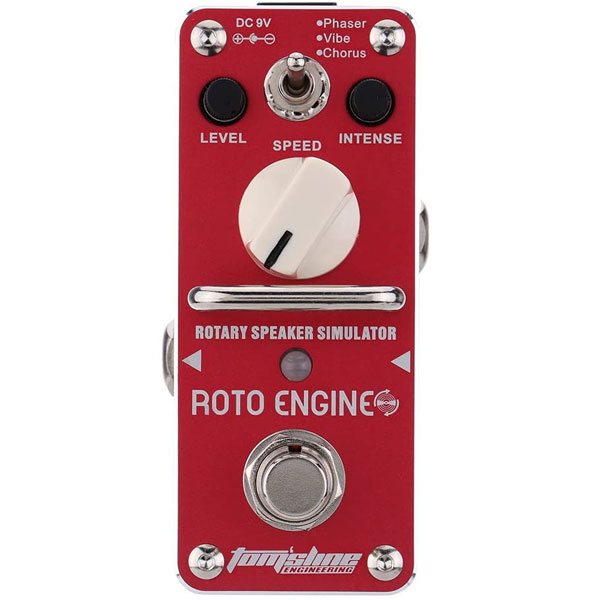
| Estimated Price | $50 |
| Type | Analog |
| Effects | Rotary |
| Connectivity | 1 x 6.35mm Jack Input, 1 x Output |
| Power | 9 Volts DC |
My Review: The Roto Engine by Aroma is an affordable, simplistic rotary speaker simulator. However, despite its minimalistic design, I found the range of complex sounds it houses to be sufficient for dramatically transforming the sound of a guitar.
The first thing I noticed about this pedal was its durable build. Smaller pedals tend to be more susceptible to wear and tear, so the robust metal chassis is a welcome addition. The LED indicator is useful when using the pedal in dark settings, and the inclusion of a toggle switch that allows you to choose between three modulation effects broadens the possibilities offered by the Roto Engine.
Who is this best suited for: With an onboard phaser, vibe, and chorus effect, the Roto Engine is ideal for guitarists looking to save space on their pedalboard. Each of these effects can be used in conjunction with the main rotary simulator, which produces unique sonic flavors.
Bottom Line: Easy to operate and built like a tank, the Aroma Roto Engine is one of the best affordable modulation pedals on the market. It doesn’t overcomplicate things and allows you to instantly shape the rotary effect using the onboard controls and toggle switch.
14. Kokko Vibe
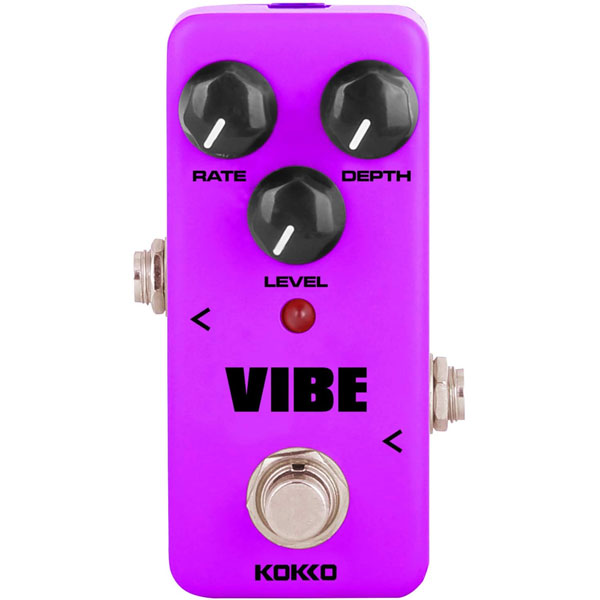
| Estimated Price | $40 |
| Type | Analog |
| Effects | Rotary |
| Connectivity | 1 x 6.35mm Jack Input, 1 x Output |
| Power | 9 Volts DC |
My Review: Although I can’t deny my fondness for high-end, complex rotary pedals, I enjoyed the contrast offered by the Kokko Vibe. Designed in a classic compact stompbox manner, this pedal utilized three controls which adust the ‘Rate’, ‘Depth’ and ‘Level of the effect.
The main quality of the Vibe pedal which makes it stand out is its equal compatibility with bass and electric guitar. This impressed me, as it’s rare for a modulation pedal to respond well to the different prominent frequencies of these two instruments.
Who is this best suited for: Guitarists and bassists who value simplicity and are looking for an affordable rotary pedal will enjoy the Kokko Vibe. It’s a great choice for those who perhaps have limited experience with modulation effects, as it is very straightforward to use.
Bottom Line: Despite its modest price tag, the Kokko Vibe includes several features which I’d more commonly associate with more expensive devices. These include anti-skid grip pads for ultimate stability, true bypass switching, a highly visible LED indicator, and four-stage phase change simulation.
15. Coolmusic A-ME01
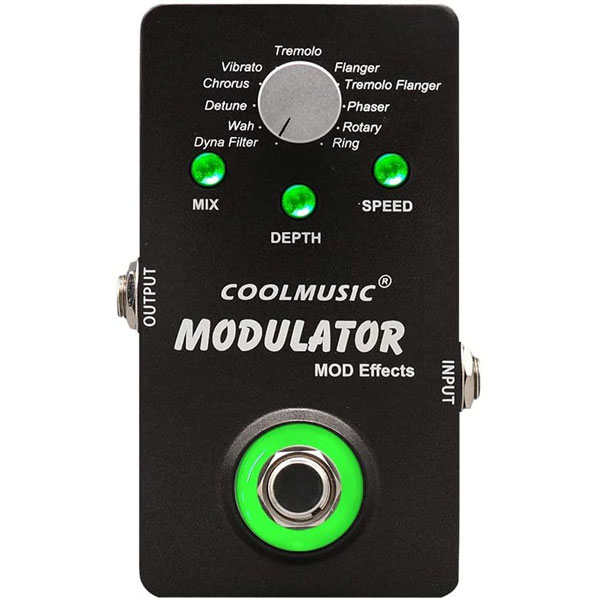
| Estimated Price | $50 |
| Type | Analog |
| Effects | Rotary, Multi-FX |
| Connectivity | 1 x 6.35mm Jack Input, 1 x Output |
| Power | 9 Volts DC |
My Review: At Guitar Lobby we’re always on the lookout for affordable multi-effects pedals which can save money and space on your pedalboard. The Coolmusic A-ME01 is of great value, considering that it includes a total of eleven modulation effects, each of which can be tailored to suit your preferences using the three adjustable parameters.
The thing I found most impressive about this pedal was its ability to keep noise to a minimum. This is an issue I’ve found on many multi-effects modulation pedals in the past, but Coolmusic has managed to design the digital circuitry to produce maximum clarity with no electronic hum or buzz present in the output.
Who is this best suited for: With eleven high-quality modulation effects and three adjustable controls, I’d recommend the A-ME01 to any guitarist looking to increase the tone-shaping possibilities they have on their pedalboard.
Bottom Line: The Coolmusic A-ME01 may be amongst the most affordable and compact pedals on this list, but there’s no denying the extensiveness of its modulation-effect producing capability. With everything from rotary to wah included on this pedal, it’s a great tool to have at your disposal.
16. Electro-Harmonix Lester G Deluxe
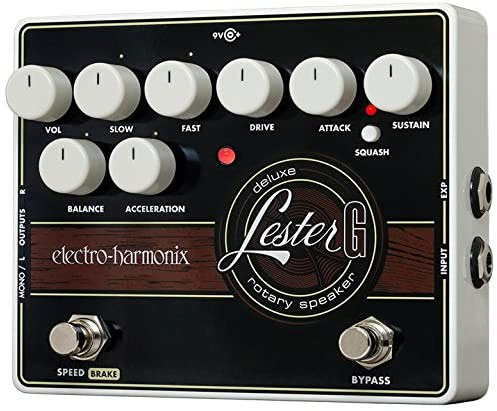
| Estimated Price | $390 |
| Type | Analog |
| Effects | Rotary |
| Connectivity | 2 x 6.35mm Jack Input, 2 x Output |
| Power | 9 Volt DC |
My Review: The Lester G shares some similarities with the aforementioned Lester K rotary pedal. However, when analyzing this device I uncovered some key differences. One of the things which stood out to me was the high-quality buffer Electro-Harmonix has installed on the pedal. This would make it a perfect choice for my pedalboard, as my cable runs often exceed the general 18.5 ft limit.
The Lester G excels at producing the classic Leslie speaker sound, but it takes things a step further with the plethora of adjustable controls you can use to tweak the presets. I was particularly impressed by the built-in compressor, which ensures that the rotary effect doesn’t dramatically influence the dynamics of the remaining pedals in the signal chain.
Who is this best suited for: The Lester G is a great choice for those who are looking to emulate the sound of a synth or organ with the Leslie effect.
Bottom Line: With an extensive range of rotary controls which cover every aspect of the effect you can imagine, the EHX Lester G is an extremely detailed pedal. It targets both the dynamics and the tonal aspects of a guitar or synth and puts you firmly in control of the pulsating effect.
17. Flamma FC05
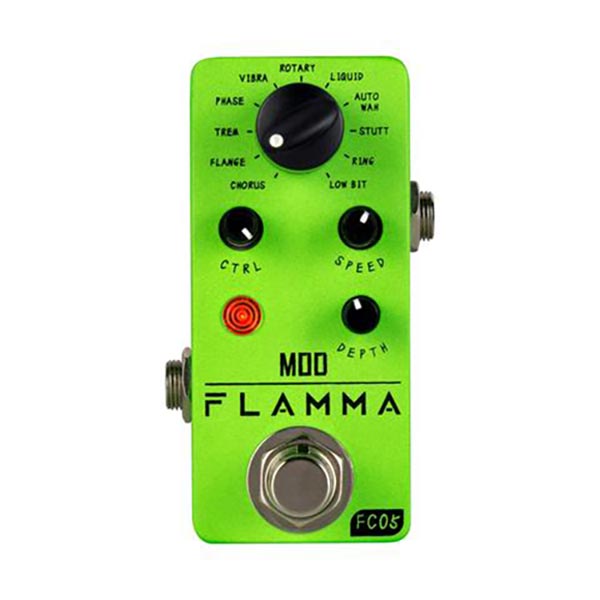
| Estimated Price | $40 |
| Type | Analog |
| Effects | Rotary, Multi-FX |
| Connectivity | 1 x 6.35mm Jack Input, 1 x Output |
| Power | 9 Volts DC |
My Review: The FC05 by Flamma is an affordable multi-effects pedal that covers a broad range of modulated tones. I was particularly impressed by three effects included on this mini stompbox – the ‘Auto-Wah’, ‘Low Bit’, and of course rotary.
Although I was expecting Flamma to have compromised on functionality to cram the eleven modulation effects into this pedal, I found the controls to be perfectly laid out to facilitate quick setting adjustments when shaping the nature of the chosen modulation effect.
Who is this best suited for: If you’re looking for an affordable rotary pedal, and intend to add more modulation effects to your rig in the future, the Flamma FC05 is highly recommended.
Bottom Line: Offering a total of eleven modulation-based effects, in addition to three useful controls designed to alter the characteristics of the presets, the FC05 is an extensive pedal at a very fair price.
A Guide to Rotary Simulator Guitar Pedals
Effects pedal discussions are often centered around the most popularly used stompboxes, such as distortion, delay, reverb, or chorus pedals. Pedals which simulate the rotary speaker effect may be less well-known than these staple effects, but the unique modulation that they offer shouldn’t be overlooked.
In the following sections of this comprehensive guide to rotary guitar pedals, we’ll take a detailed look at how the effect is produced, and how you can ensure that you get the best out of the new addition to your signal chain.
Rotary Speakers Explained
The rotary guitar pedals featured in this article are all based on a specific type of speaker, designed by Don Leslie in the mid-twentieth century. It was created as an additional tool to be used with a Hammond organ, to mimic the wide sonic range of a pipe organ.
Leslie’s name is synonymous with rotary speakers, and in some cases, they are even referred to as ‘Leslie Speakers’. The effect can be heard in many of The Beatles’ recordings post-1966, or Hendrix’s masterpiece ‘Little Wing’.
Despite the word ‘rotary’ being linked to a sense of motion, the components in a Leslie speaker don’t move at all. The effect is created by the sonic direction of rotating other objects. For example, in the early Leslie speaker units, a drum and a horn would rotate to create the effect.
Unfortunately, it would be very impractical to lug a large rotary speaker around as part of your guitar rig. The units are stereotypically bulky, and wouldn’t even fit on the majority of pedalboards. Thankfully, rotary simulator pedals provide guitarists with a practical solution so that they can still enjoy the unique sounds offered by Leslie’s creation.
Parameters and Controls
As is the case with all effects pedals, some models offer a more extensive range of adjustable controls than others. Rotary speakers do vary in this aspect, but you can expect to see a combination of the following parameters:
- Drive
- Slow
- Fast
- Blend
- Sensitivity
‘Drive’ controls are featured on almost all rotary simulator guitar pedals. This adds gain to the signal, which causes mild overdrive and saturation. When the ‘Drive’ parameter is set to a high level, the pedal produces the sound of a blown-out Leslie speaker.
‘Slow’ and ‘Fast’ parameters are perhaps the most important when it comes to shaping the rotary effect to suit your preferences. These two controls increase or reduce the prominence of the fast and slow-paced rotations, and can be blended to create interesting combinations.
‘Blend’ controls are also heavily featured on rotary pedals. This parameter allows you to adjust the balance between the dry sound of the guitar and the wet sound of the rotary effect. Finally, ‘Sensitivity’ is a useful control for adjusting the way that the modulation effect is impacted by the velocity of your guitar playing – when you dig into the strings, more of the rotary effect will be present in the output and vice versa.
Recording with a Rotary Pedal
A huge benefit of rotary guitar pedals is that they provide you with an authentic reproduction of the effect produced by a large Leslie speaker unit. This has obvious implications onstage, but it also makes it possible for you to use the rotary effect in your recordings.
Some musicians prefer to use VST plugins to apply modulation effects to their recordings. Plugins are easy to customize and adjust, and they can be applied directly to the recorded audio after it has been captured.
However, many musicians would rather use effects pedals, like a rotary sim stompbox, to process their recordings. Using a rotary pedal in the studio is simple, and can be broken down into two possible methods.
Firstly, the conventional way to record with a rotary speaker pedal would be to simply plug into your amplifier, set up a microphone in front of it, apply the rotary effect via the pedal, and capture the take in your chosen recording software.
The second method you could use consists of plugging your guitar into the rotary simulator pedal’s input, then sending the output directly into an audio interface, preamp, mixer, or another recording device. This removes the need for an amplifier and is a more practical way to record the rotary effect.
True Bypass vs. Buffered Rotary Pedals
When sifting through the many rotary pedals on the market, one important thing to consider is whether you should opt for a true bypass device or a buffered option. Rotary pedals, like all other effects, use one of these designs to ensure that signal strength is maximized and noise issues are kept at bay.
Rotary pedals with true bypass switching perform best if your total cable length is less than 18.5 ft. They work by allowing the signal of the guitar to pass through the inner electrical components of the pedal, even when the device is not active.
On the other hand, buffered rotary pedals are fitted with a mechanism that amplifies the signal as it goes into the pedal. This increase in signal strength ensures that there is no loss of volume or alteration to the prominent frequencies produced by the guitar.
Extensive pedal selections benefit from beginning the signal chain with a buffered pedal. This is because the buffer prepares the signal for the pedals which succeed it in the chain. It’s advised to always begin the chain with a buffered pedal if possible, but there’s no harm in combining true bypass and buffered pedals on your pedalboard.
Positioning a Rotary Pedal in Your Signal Chain
Rotary guitar/speaker pedals belong to the modulation effect category. Other effects included in this group are chorus pedals, phasers, flangers, vibrato, and tremolo pedals. Modulation pedals are amongst the most transformative in terms of the effect they have on a guitar’s clean tone.
There’s no right or wrong position for a rotary pedal in your signal chain, but there are some general rules which many musicians prefer to adhere to. Conventionally, the signal chain is ordered as follows:
- Tuner pedal
- Dynamic effects (Compressor, EQ, Limiter, Boost Pedal, Wah)
- Gain effects (Distortion, Fuzz, Overdrive)
- Modulation Effects (Chorus, Phaser, Rotary Pedal, Flanger)
- Timing Effects (Delay, Reverb)
When using this conventional approach, the rotary simulator pedal is positioned before the delay and reverb effects. This prevents these effects from creating a muddy, hectic tone when they are engaged simultaneously.
Experimenting with different positions for your rotary guitar pedal in the signal chain is a great way to learn about how the Leslie-style effect interacts with other pedals. You might even stumble across an interesting signal chain order which perfectly suits your style of guitar playing!
Rotary Pedals with Multiple Inputs & Outputs
Many rotary guitar pedals have multiple inputs and outputs installed on them. This broadens the possibilities you have when connecting the pedal to an amplifier, or another device.
Having two outputs on a rotary pedal makes it possible to split the ‘wet’ and ‘dry’ signals from the pedal, sending them to separate amplifiers. This is a useful technique for guitarists who would like to keep their tone thick and powerful when their effects are engaged.
Rotary pedals may also include multiple inputs, which can be used to connect an external device, such as an expression pedal. They may also have mono and stereo inputs to facilitate using different types of instruments with the rotary effect.
Powering Your Rotary Pedal
When it comes to supplying your rotary speaker pedal with the power it requires, by far the most reliable method is to use a Power Supply Unit (PSU). These power bricks include multiple DC outputs of varying voltages and are connected to the pedal via a small power cable.
The main advantage of using a PSU for powering rotary and all other pedals is that you can leave the cables plugged into the relevant pedals constantly so that your signal chain is always ready to use whenever you need it.
Alternatively, some rotary simulator pedals may also facilitate battery power, most commonly using a single 9v DC battery. Connecting batteries to your pedals is a great backup, in case your power supply malfunctions mid-performance or during a recording take. However, it’s best not to rely solely on batteries as you run the risk of their power being drained.
Final Words
Rotary pedals produce unique sonic results which add a feeling of movement to a guitar’s output. They may not be the most well-known or popular pedals out there, but the sense of depth and harmonic richness they provide make them a great addition to the signal chain.
After reading this detailed guide, you should now have all of the necessary information you require to choose the best rotary speaker pedal for your needs.

My name is Chris and I’ve had a passion for music and guitars for as long as I can remember. I started this website with some of my friends who are musicians, music teachers, gear heads, and music enthusiasts so we could provide high-quality guitar and music-related content.
I’ve been playing guitar since I was 13 years old and am an avid collector. Amps, pedals, guitars, bass, drums, microphones, studio, and recording gear, I love it all.
I was born and raised in Western Pennsylvania. My background is in Electrical Engineering, earning a Bachelor’s degree from Youngstown State University. With my engineering experience, I’ve developed as a designer of guitar amplifiers and effects. A true passion of mine, I’ve designed, built, and repaired a wide range of guitar amps and electronics. Here at the Guitar Lobby, our aim is to share our passion for Music and gear with the rest of the music community.

I’m looking for a Leslie speaker pedal. Is that the same thing as a Rotary pedal? I’m looking at the Fender but then I also saw the Strymon.